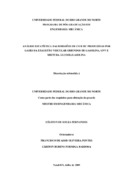Use este identificador para citar ou linkar para este item:
https://repositorio.ufrn.br/handle/123456789/15566| Título: | Análise estatística das emissões de CO e HC produzidas por gases da exaustão veicular oriundos de gasolina, GNV e mistura álcool/gasolina |
| Autor(es): | Fernandes, Céliton de Souza |
| Orientador: | Fontes, Francisco de Assis Oliveira |
| Palavras-chave: | Análise estatística;Emissões;Monóxido de carbono;Hidrocarbonetos;Gás natural veicular;Gasolina;Álcool;Statistical analysis;Emissions;Carbon monoxide;Hydrocarbons;Compressed natural gas;Gasoline;Alcohol |
| Data do documento: | 13-Jul-2009 |
| Editor: | Universidade Federal do Rio Grande do Norte |
| Referência: | FERNANDES, Céliton de Souza. Análise estatística das emissões de CO e HC produzidas por gases da exaustão veicular oriundos de gasolina, GNV e mistura álcool/gasolina. 2009. 112 f. Dissertação (Mestrado em Tecnologia de Materiais; Projetos Mecânicos; Termociências) - Universidade Federal do Rio Grande do Norte, Natal, 2009. |
| Resumo: | Os veículos automotores são as principais fontes móveis de Monóxido de Carbono (CO) e Hidrocarbonetos não queimados (HC) lançados na atmosfera. Nos últimos anos o acréscimo da frota de veículos no município de Natal-RN vem contribuindo para o aumento das emissões desses gases poluentes. O estudo consistiu de uma análise estatística das emissões de CO e HC de uma amostra composta por 384 veículos com motorização a Gasolina/GNV ou Álcool/Gasolina/GNV do município de Natal-RN. Os testes foram realizados em veículos submetidos à Inspeção de Segurança Veicular, nas instalações do INSPETRANS, Organismo de Inspeção Veicular. Um analisador de gases parcial permitiu medir, para cada veículo, os níveis de CO e HC em duas condições de rotação do motor (900 e 2500 rpm). A análise estatística realizada por meio do software STATISTICA revelou uma sensível redução na eficiência dos conversores catalíticos após 6 anos de uso com a emissão média de 0,78 % de CO e 156 (ppm) de HC, o que representa aproximadamente 4 (quatro) vezes a quantidade de CO e o dobro de HC em comparação com os veículos mais novos. O resultado de um Teste-T de Student sugere fortemente que a média das emissões de HC (152 ppm), a 900 rpm, é 40% maior que a 2500 rpm, para o motor sem carga. Esse resultado revela que a eficiência da conversão catalítica é limitada cineticamente em baixas rotações. O Estudo conclui também que ao comparar as emissões de CO e HC, considerando a influência dos combustíveis, verificou-se que embora as emissões de CO a partir do GNV sejam 62% menores do que a partir da gasolina, não há diferenças significativa entre as emissões de HC oriundas do GNV e da gasolina. Em síntese, os resultados colocam os atuais critérios de inspeção veicular, para gases da exaustão, em dúvida, conduzindo a criação de limites de emissão de poluentes mais rigorosos, visto que a eficiência dos conversores catalíticos é sensivelmente reduzida a partir de 6 anos de uso. Suscita-se também a possibilidade de modificações nas condições de teste adotadas pelas normas atuais, especificamente na rotação do motor, haja vista que na condição sem carga os maiores índices de emissão foram registrados em marcha lenta. De ante disso, sugere-se a dispensa dos testes em altas rotações, reduzindo à metade o tempo de inspeção e gerando economia de combustível |
| Abstract: | The vehicles are the main mobile sources of carbon monoxide (CO) and unburned hydrocarbons (HC) released into the atmosphere. In the last years the increment of the fleet of vehicles in the municipal district of Natal-RN it is contributing to the increase of the emissions of those pollutants. The study consisted of a statistical analysis of the emissions of CO and HC of a composed sample for 384 vehicles with mechanization Gasoline/CNG or Alcohol/Gasoline/CNG of the municipal district of Natal-RN. The tests were accomplished in vehicles submitted to Vehicular Safety's Inspection, in the facilities of INSPETRANS, Organism of Vehicular Inspection. An partial gases analyzer allowed to measure, for each vehicle, the levels of CO and HC in two conditions of rotation of the motor (900 and 2500 rpm). The statistical analysis accomplished through the STATISTICA software revealed a sensitive reduction in the efficiency of the converters catalytic after 6 years of use with emission average it is of 0,78% of CO and 156 (ppm) of HC, Which represents approximately 4 (four) times the amount of CO and the double of HC in comparison with the newest vehicles. The result of a Student s t-test, suggests strongly that the average of the emissions of HC (152 ppm), at 900 rpm, is 40% larger than at 2500 rpm, for the motor without load. This result reveals that the efficiency of the catalytic conversion is limited kinetically in low engine speeds. The Study also ends that when comparing the emissions of CO and HC considering the influence of the fuels, it was verified that although the emissions of CO starting from CNG are 62% smaller than arising from the gasoline, there are not significant differences among the emissions of HC originating from of CNG and of the gasoline. In synthesis, the results place the current criteria of vehicular inspection, for exhaust gases, in doubt, leading the creation of emission limits of pollutant more rigorous, because the efficiency of the converters catalytic is sensibly reduced starting from 6 years of use. It is also raised the possibility of modifications in the test conditions adopted by the current norms, specifically in the speed engine, have seen that in the condition without load the largest emission indexes were registered in slow march. That fact that allows to suggest the dismissal of the tests in high speed engine, reducing the time of inspection in half and generating economy of fuel |
| URI: | https://repositorio.ufrn.br/jspui/handle/123456789/15566 |
| Aparece nas coleções: | PPGEM - Mestrado em Engenharia Mecânica |
Arquivos associados a este item:
| Arquivo | Descrição | Tamanho | Formato | |
|---|---|---|---|---|
| CelitonS.pdf | 1,83 MB | Adobe PDF |  Visualizar/Abrir |
Os itens no repositório estão protegidos por copyright, com todos os direitos reservados, salvo quando é indicado o contrário.

